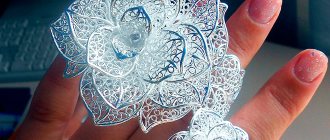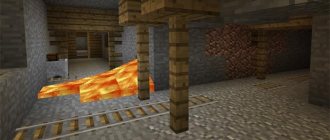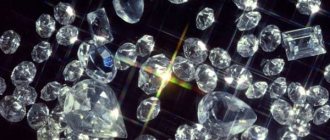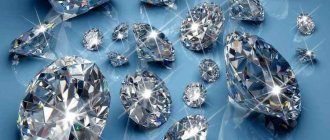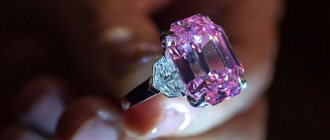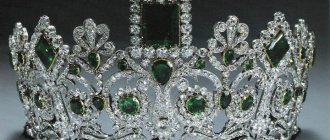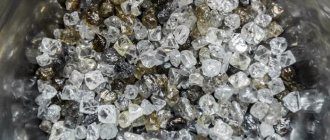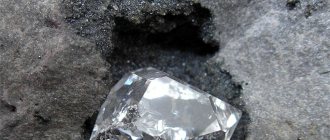A natural diamond is an incredibly beautiful, very hard and durable stone that gives an unsurpassed shine. But at the same time it is also very expensive. Synthetic diamonds are much more common than regular diamonds made by nature. The fact is explained by the fact that in nature there are imperfect stones, with defects, their sizes are far from ideal. In laboratory conditions, it is possible to create artificial diamond for jewelry, electronics, medical equipment and industrial needs. Of course, the technology is complex and financially expensive; scientists have been developing a satisfactory method for decades.
How did synthetic diamonds originate?
Artificial diamonds
The history of the emergence of synthetic minerals dates back to 1797. It was then that scientists began to study the structure of natural materials and found out that diamond consists entirely of carbon. But it was not possible to produce carbon using production facilities. Therefore, work has not progressed from theory to practice in creating an artificial mineral.
The possibility of creating a solid element in the laboratory was again discussed in 1926. A team of French scientists came closer to the truth, but they failed to make a stone that would satisfy in appearance and be correct from the technical side of the issue. The problem was that the crystal lattices of the durable mineral could not be transmitted using the equipment of that time.
In 1942, the patent for the research was acquired by General Electrics. Despite the turbulent military situation, the company began thorough research. Experts have found that the necessary technical characteristics can be imparted to a substance only at high pressure and by raising the temperature. They created laboratory conditions unprecedented for that time: pressure of 5 hPa and heating to 3 thousand degrees Celsius. The first diamond, which had detailed parameters for the strength of light refraction and structure, was created only a decade later - in 1951.
Scientists synthesize artificial diamonds
Three years later, a company with technology for producing artificial diamonds enters the market. It was not possible to use stones in jewelry, since the sizes of the artificial components created were small. But industrial and even military firms became interested in them. Artificial diamond has also begun to be used for the production of medical equipment.
It was possible to solve the problem with miniature sizes only by 1970. Stones began to be produced in sizes larger than 1 carat, which was enough for jewelers to start making jewelry with artificial stone inserts.
Worth knowing! Now hundreds of companies around the world are engaged in the production of diamonds in laboratory conditions. They produce diamonds of various sizes, shapes, and interesting color palettes. The largest specimen, which was grown artificially, measures 34 carats. It is listed in the Guinness Book of Records.
Is it possible to get diamond from coal?
It is quite possible to grow a diamond at home from coal. For this you will need:
- heat-resistant flask or glass for 2–3 liters;
- smaller flask;
- pestle and mortar;
- charcoal, store bought;
- seed in the form of a natural diamond crystal;
- paper filters.
A microscope is useful to monitor the process, but even without it the gem will grow. Growing stages:
- Grinding charcoal in a mortar and pestle. Small pieces measuring 3–5 mm will do.
- The resulting mass is poured into a heat-resistant container and filled with distilled water so that it is completely hidden. You cannot fill the container completely - the liquid will run away when heated.
- The container is placed on very low heat. As it boils, water is added. This stage can take from several hours to several days.
- The resulting yellow, carbon-rich solution is passed through paper filters, poured into a small test tube, and evaporated again. This is repeated 3-4 times. The color of the liquid becomes deep yellow.
- After 2-3 days, a small test tube with the resulting solution is placed in a warm place. A small diamond crystal is lowered into it, on which the growth of carbon lattices begins. When evaporating, you need to add a new solution - the future diamond should not come into contact with air.
The process is very slow - 0.01 carats increase per year. Therefore, the larger the seed crystal, the faster the growth will occur.
In addition to the topic of the video, how the process of making a diamond from glass occurs:
Making a diamond with your own hands and without significant costs is real. The resulting stones can be used to create decor and interior decoration. The main thing you need when growing a gem is patience.
Want to make a diamond yourself? Do you have growing experience? Tell us in the comments. Share the information with your friends and acquaintances - they will be interested in it.
Features of artificial diamonds
An artificial diamond cannot be called a copy; from a physical point of view, this is incorrect. The fact is that diamonds made by nature and by human hands are identical in their indicators, in particular, hardness on the Mohs scale, refractive index of solar rays and other parameters. They differ in that they are produced in different ways. Diamonds retain the properties of a natural nugget. In particular, the characteristics are identical:
- strength;
- shine;
- structures;
- textures;
- refractive index of solar rays;
- nominal weight;
- resistance to electric charge;
- ability to conduct heat;
- elasticity;
- melting temperature, etc.
Of course, in laboratory conditions it is possible to produce stones free of defects. The material obtained is identical to what nature could create under the best conditions. Only 20% of the total number of nuggets mined in world production are used in jewelry. The rest have inclusions, defects, and a cloudy surface, so they are used for technical purposes only. This explains the fact that artificial diamonds in most jewelry products and devices have long been replaced by artificial analogues.
An artificial diamond is called by different names. Scientists divide copies into so-called HPHT minerals - their production requires exposure to high temperatures and pressure; CDV stones, the production of which uses vapor deposition of chemical elements. Growing diamonds is also possible using other technologies - the types obtained are moissanite, rhinestone, cubic zirconia, fabulite, rutile, cerussite and others. The synthetic diamond obtained in this way is not a true copy, since it does not completely copy the characteristics. A common misconception concerns the cubic zirconia stone, which even an experienced jeweler cannot distinguish from a diamond by its appearance.
Brooch in the shape of a turtle, decorated with cubic zirconia
How does a synthetic diamond differ from natural stones?
Synthetic diamond has identical characteristics. The indicators are the same, in particular:
- Chemical formula - carbon 100%
- Refractive index - 2.42
- Variance - 0.044
- Hardness - 10 (the highest point on the Mohs scale)
- Density - 3.52.
As can be seen from the list, the characteristics of a real diamond and a natural diamond are indistinguishable. But, an artificially grown diamond is obtained in a few hours or days, while a natural mineral will take hundreds of years to form.
Externally, only an experienced jeweler can distinguish an artificial diamond from a real one. On the left is real stone, on the right is synthetic.
Creating synthetic materials for jewelry is a lucrative industry. The cost of an unnatural diamond can be higher than one created by nature if it is huge. Natural stones are inferior in appearance, as they have cracks, chips, and clouding. At the same time, no matter what the name of an artificial diamond is, it has the following features:
- there are no slightest inclusions or unevenness in texture;
- there are no cracks inside the stone that distort the passage of the sun's ray;
- the color does not fade over time.
An artificial diamond is unpretentious. If products with natural stones need to be periodically sent to salons for cleaning, then making a stone made in a laboratory sparkle is a matter of a few minutes. You will need to choose an available cleaning product with any level of abrasiveness and thoroughly rub the stone.
Rings and earrings with artificial diamonds
Is it possible to get diamond from graphite?
300 years ago, coal, graphite and diamond were completely different substances. In the 17th century, the first studies appeared confirming the relationship of dissimilar objects.
In England, Tennant, who studied chemistry, was able to do an experiment that revealed that they were all made of carbon. Indeed, outwardly there can be no talk of any similarity.
- Dark gray, shiny, closer to pasty than solid, consisting of scales sliding over each other - this is graphite. Its hardness on the Mohs scale is 2 points, where talc is taken as 1. It is used as a lubricant between surfaces sliding over each other and in the manufacture of pencils. Conducts current.
- Coal is black and may shine when broken. Completely opaque. Hardness from 2 to 5 points due to oxygen and nitrogen impurities that react with carbon, making the structure more dense.
- Diamonds are the standard of hardness among stones, 10 out of 10. They are transparent and are used for cutting glass. They do not conduct current.
In 1955, the experiment was crowned with success - under the influence of temperature and pressure, the layered crystal lattice of graphite was rebuilt into a tetrahedral diamond one.
Conditions for turning graphite into diamond:
- temperature 1800 °C;
- pressure of 120 thousand atmospheres.
Modern methods for synthesizing diamonds from graphite
Artificial diamond can be made from carbon-rich substances (soot, graphite, sugar coal, etc.) at high pressure (more than 50 thousand atmospheres) and temperatures above 1200 ° C with the addition of catalysts. Crystals grow in methane.
Produced synthetic stones differ in strength:
- ASO – normal strength;
- ASR – increased strength;
- ASV – high strength;
- ASK and ACC are monocrystalline diamonds.
It is possible to make a synthetic diamond from graphite by following the steps of a complex technological process.
- First, the necessary conditions for crystal growth are created in a special chamber. Each diamond grows individually. One laboratory is capable of growing no more than 200–300 diamonds per year.
- After growing, the stone is given color. The color of laboratory diamond is honey-yellow due to nitrogen. To obtain yellow, pink, green, red shades, post-growth thermobaric treatment (HPHT) technologies are used - additional annealing of the mineral at high temperatures and pressures.
Making your own diamond from graphite
There are 2 main ways to grow a fairly large diamond at home.
To quickly make a diamond from graphite with your own hands, you will need:
- power source, for example, a welding machine;
- pencil graphite;
- the wire;
- cold water or liquid nitrogen.
The essence of the process is this:
- graphite must be connected to a wire and placed in a container;
- the structure needs to be cooled strongly, this can be done with liquid nitrogen or by freezing in a freezer;
- After cooling, apply current to the wire.
After passing an electrical charge, graphite is transformed into diamond. Precautions must be taken when working with electrical appliances. If current passes, the capacitance may pose a hazard.
Video on the topic:
Real diamond can be made from graphite in a safer way. It requires:
- distilled water (40 ml);
- table salt (100 gr.);
- pencil lead (12 g);
- strong thread.
First you need to mix the dry ingredients, then pour in the distillate and leave for a day. Next, the resulting solution is poured into another container, preferably one with a narrow neck, but not poured out completely; it will come in handy later.
At the bottom of the container, crystals are found - the basis of the future stone. The largest one is tied to one end of the thread and lowered into the drained solution. The second end is tied to a toothpick, pencil or any wooden stick located on top of the dish with the solution.
When water evaporates, new components of the future stone will settle on the crystalline base. If there is a lot of solution, then you can make several points of gem growth at the same time. To obtain a large stone, the solution is prepared again. A new portion is added as the previous one evaporates.
To re-receive the liquid, you can dissolve the small crystals that have formed at the bottom of the container in warm water.
To make a mineral successfully, you must comply with the following conditions:
- there should be no temperature changes in the room;
- monitor the liquid level - the growing stone should not be exposed to air.
Methods for growing synthetic diamonds
A man-made diamond is called a stone that does not require many steps to produce. However, strict laboratory conditions must be observed. Fluctuations of even a hundredth of a degree in temperature will lead to disastrous results.
The technology in demand is under the influence of pressure and high temperature. The material – crystalline carbon – is placed in a vessel and then placed under a press. Water is supplied to the grate with a strong stream. It acts on crystalline carbon under high pressure. To further increase this figure, refrigerants are added. The pressure increases 10 times and reaches 5 hPa.
After reaching the required pressure, an electrical bus is connected to the crystal lattice. Current is supplied through it. As a result, the material heats up quickly. Graphite turns into a solid stone. At the final stage, the structures are defrosted and the liquid remaining from the refrigerants is drained. Artificial diamonds are removed and further processed.
The process of making artificial diamonds at a factory
Growing diamond with methane
Growing diamonds with methane is an affordable technology. Its use is not difficult, but safety rules must be followed. Methane technology is a method in which a crystal of artificial stone is obtained under the influence of an explosion of a substance.
A methane explosion leads to disruption of the integrity of the carbon lattice. The artificial diamond grows, the procedure is repeated again. No special temperature requirements are required.
There are several methane explosion technologies. The first is that an impulse push occurs. There are a lot of stones, but they are small in size. The second method is that the diamond is blown with methane at a temperature of 1100 degrees Celsius. The second method is expensive and requires laboratory conditions. But the result is a stone of any size, which is sold at a bargain price.
WHAT IS A SYNTHETIC DIAMOND
At the end of the 18th century, scientists discovered that diamond is a form of carbon. This marked the beginning of numerous attempts to recreate the gemstone from available materials such as coal or graphite.
How did artificial diamonds come about?
Since the 19th century, many famous physicists and chemists have announced the successful completion of experiments in growing diamonds. True, none of these statements have been documented.
Only in 1927, the Soviet physicist O. Leypunsky made a breakthrough by calculating the conditions necessary for the process. Further research and experiments were carried out in parallel in the USSR, USA and Switzerland.
HPHT and CVD
The first working installation for crystal synthesis was created and patented by the Swede Balthasar Platen. He learned his method from nature.
Platen recreated similar conditions: a cell with nickel, cobalt and iron was heated and pressed with a multi-ton press. In this case, metals acted as a catalyst, and presses simulated pressure of thousands of atmospheres.
This method is called HPHT (High Pressure High Temperature) - high pressure, high temperature. The method is imperfect, but simple and inexpensive. Today it is used for the mass production of industrial diamonds and diamond dust.
In the 60s of the 20th century, a more advanced method was invented: CVD (Chemical vapor deposition) - chemical vapor deposition. The essence of the technology is the crystallization of diamonds from hydrocarbon gas onto a substrate grown by the HPHT method. CVD allows for the creation of larger, purer crystals.
Nano diamonds
In addition to HPHT and CVD, there are other, more narrowly focused technologies:
- detonation synthesis of diamonds - high temperatures and pressures are obtained due to the detonation of graphite. As a result of the decomposition of carbon-containing substances, nanocrystals are formed;
- ultrasonic synthesis of nanodiamonds - allows you to synthesize microcrystals from a suspension of graphite in an organic liquid at normal pressure and room temperature.
Similarities and differences
For a long time, HPHT diamonds and CVD diamonds differed from natural ones in size - under artificial conditions it was impossible to grow a stone larger than a carat. But many companies continue to work to eliminate this shortcoming.
Today, stones with the following characteristics are grown under artificial conditions:
Artificial diamonds have differences from natural ones:
- “artificial” may have metal inclusions left over from production;
- on colored stones you can see growth sectors that appear due to accelerated crystallization processes;
- Natural and artificial crystals luminesce differently in UV rays.
These differences can only be seen with specialized equipment. Therefore, suppliers and sellers of artificial diamonds are required to indicate on the product tags information about the origin of the crystals.
Advantages and disadvantages of artificial diamonds:
- identity with natural stones;
- creation without interfering with nature;
- lower price.
- the shortcomings are due to imperfect production - few enterprises have the equipment capable of creating diamonds of the required size, purity and at a competitive price.
Color range of laboratory stones
Gas colorless diamond is a popular option. It is these stones that are more valuable in the jewelry market. But the difficulty is that it is more difficult to grow a transparent diamond than others. It requires effort and strict adherence to temperature parameters during production.
Transparent diamonds are obtained only if boron or nitrogen is not present in the original composition. Even the smallest ingress of chemical elements into the composition leads to tarnishing. This is not uncommon, which is why diamonds that are completely clear are the most expensive. They sell at a price identical to natural diamonds. Specimens from 1 carat are valued.
Synthetic colorless diamonds
Blue diamonds are produced by adding the element bromine to the crystalline carbon lattice. If a minimum of it hits, the finished diamond acquires a slight bluish tint. With a large ratio, the resulting stones have a bright blue tint.
Gold earrings with synthetic corundum and diamonds
Yellow, unnatural diamonds are produced by adding nitrogen. Receiving on the company’s equipment takes a minimum of time, so such options do not have a high price. You can make lemon, orange, yellow, sand variations.
Engagement ring with synthetic yellow and clear diamonds
Recently, black diamonds have begun to be created in production. They look interesting and are suitable for stylish jewelry. In the form of inserts they are used for rings, earrings and necklaces. Nickel is used during the production of black diamonds.
Black diamonds created by synthesis
WHAT ARE ARTIFICIAL DIAMONDS CALLED?
According to the prevailing stereotype, “artificial” is something only externally similar to the original. But imitation does not always mean fake.
Since modern grown diamonds are identical to natural ones, marketers propose replacing the established term “artificial diamond” with wording that would reflect the nature of the origin of this stone more accurately:
- “created”;
- “grown in a laboratory”;
- “created in the laboratory.”
Where are they in demand?
It is difficult to distinguish natural from laboratory stones, since scientists create crystals that are identical to natural ones in every way. Most of the produced raw materials go to industry and for scientific purposes. The purest samples are needed for nanotechnology and precision engineering. They are used in the construction of especially durable tools - drills, knives, circles.
Like natural, synthetic stones are in demand in jewelry. Synthetic crystals already account for more than 2% of the diamond market, and this figure is increasing.
Artificial stones are used in industry and jewelry
Industrial Application
Diamond is a stone known for its durability. The invention of synthetic diamond gave the industry new opportunities: laboratory specimens turned out to be harder, more practical, and more uniform. This made it possible to use them as a particularly hard cutting tool, including in the design of units for diamond processing.
Both natural and laboratory diamond have enormous thermal conductivity and low electrical conductivity. Thanks to this combination, the industrial diamond is an advantageous heat sink used in laser diodes and transistors. Thanks to the quality of heat dissipation, electronics last longer and require less repair and replacement. Diamond thermal spreaders are the best way to prevent semiconductor overheating.
Diamond is inert, hard, and slightly expands, so it is suitable for the output window of microwave and infrared radiation. Practice has shown that laboratory diamond is more effective than zinc selenide and silicon.
In electronics, diamond is going to be used as a semiconductor - this area of application is still being researched. Due to the high mobility of electrons, industrial diamond has dielectric properties suitable for transistors. Transistors constructed with diamonds last longer at high temperatures and suffer less from radiation and mechanical wear.
Crystals are needed in industry
Beautiful death: new technology for obtaining jewelry
In 1999, scientists learned to obtain diamond from the ashes of a person or animal. After 3 years, the technology received wide publicity and the creation of diamonds from remains turned into a profitable business. The technique does not stand still. Previously, to produce the stone, all the ashes from cremation were required, but today a lock of hair is enough.
When a person is cremated, very high temperatures are required. Thanks to this, it became possible to preserve loved ones in jewelry. But the price for such a burial is not small: $5,000-22,000.
Attention! The prices indicated on the website are not a public offer, and the administration is not responsible for them.
You can receive a stone from the ashes of your loved ones in 12-14 weeks, depending on the complexity of the order. The size of such diamonds ranges from 0.25 to 2 carats. Price varies depending on color and size. To create one carat of yellow diamond, you will need 100 g of ashes or 35-40 g of hair and $6,250. To grow a blue mineral, 500 g of ash or 100 g of hair are spent. Its price starts at $11,750 per carat.
